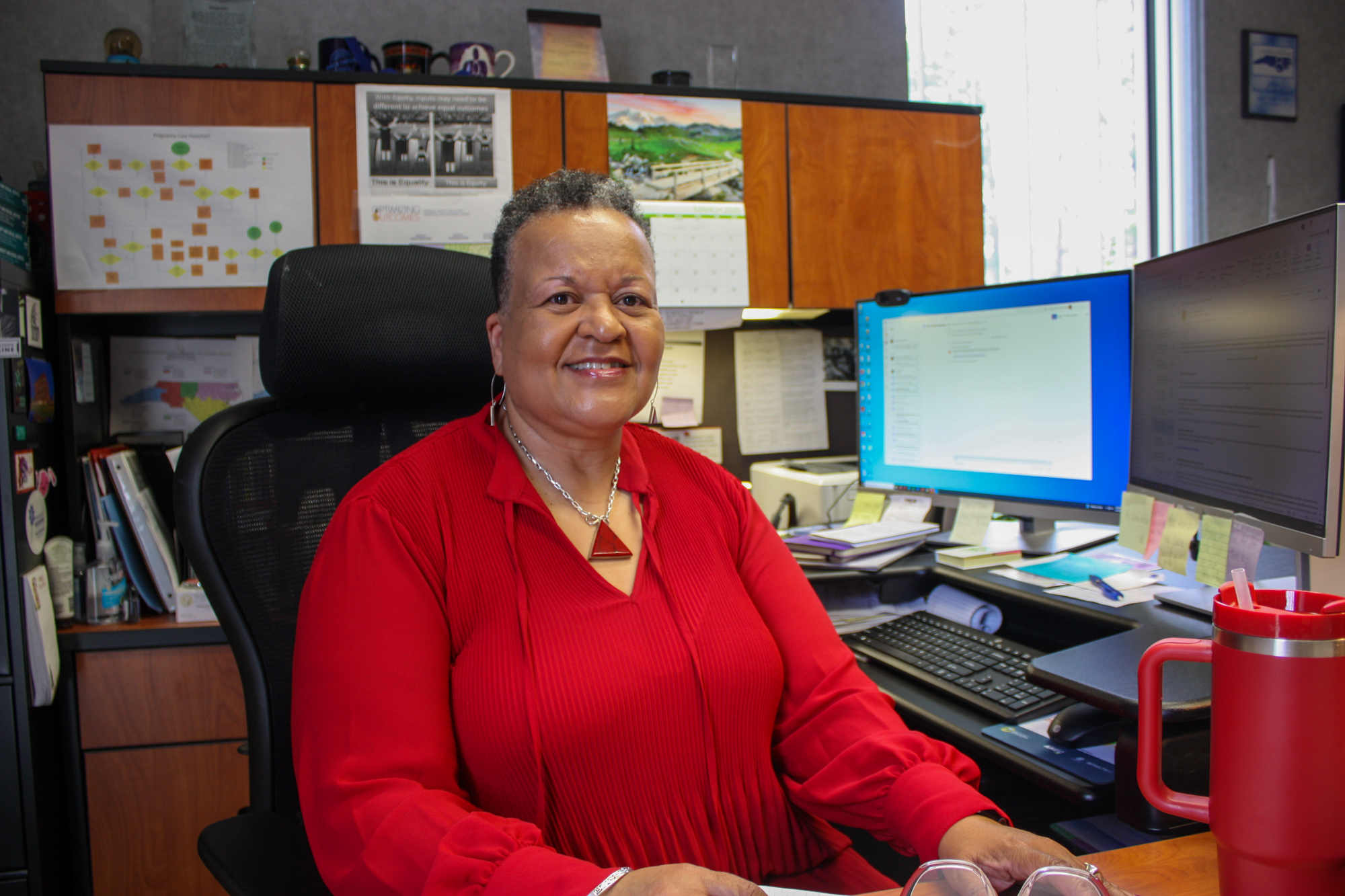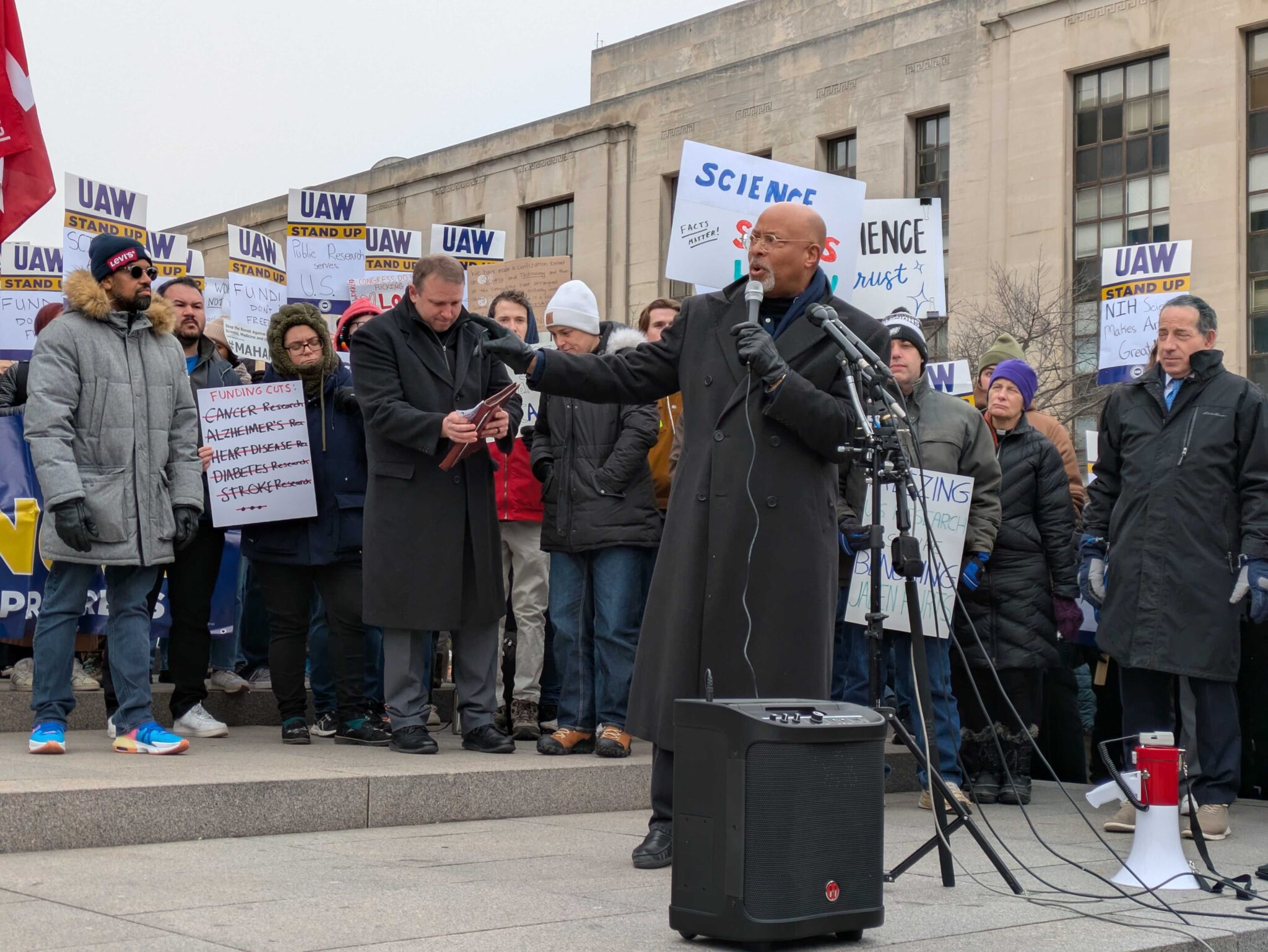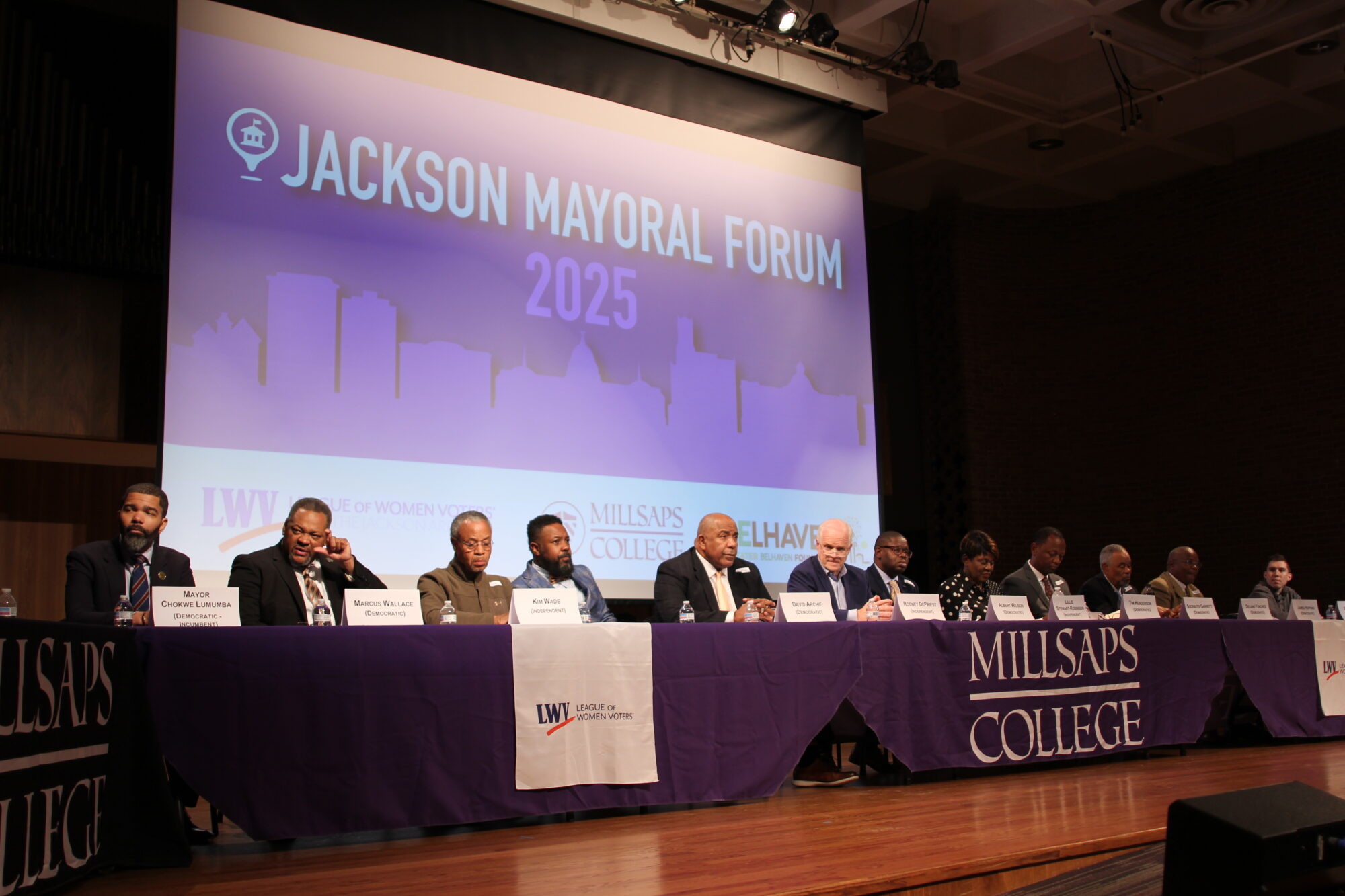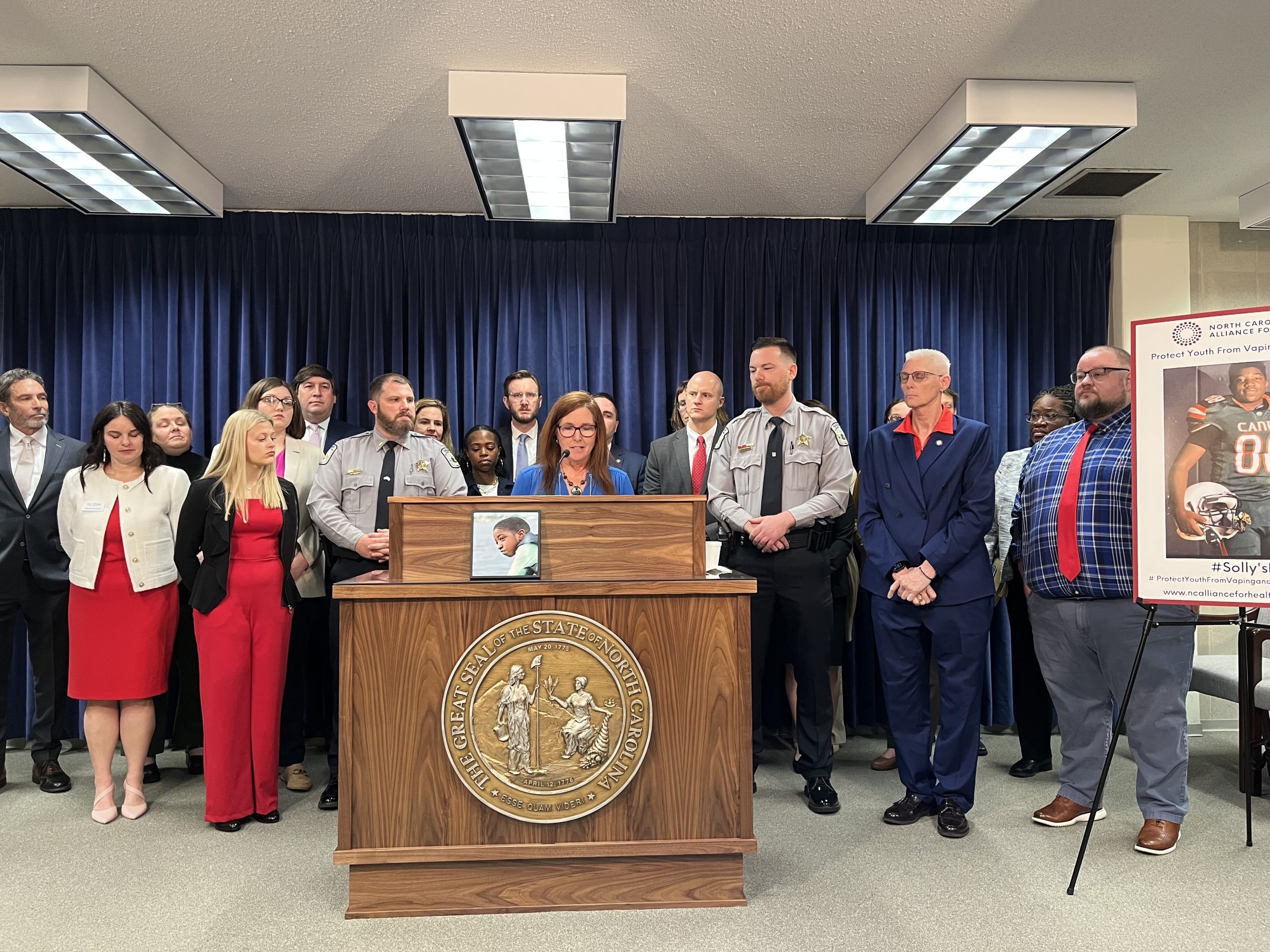The House Oversight Committee Wants Answers From FEMA on the Hurricane Helene Response
Memphis domestic violence center closes because of lack of funding

Good morning. It's Friday, March 21, 2025, and in this morning's edition we're covering the U.S. House Oversight Committee wants answers from FEMA about the Helene response in Western North Carolina, HUD cuts will cripple affordable housing development, the paradox of North Carolina's rural women's health services, fired federal workers want their job back but linger in an administrative leave status, how Texas conservatives are using school board elections to influence what students learn, Jackson, Miss. mayoral candidates participate in a forum, N.C. General Assembly could pass legislation raising age for tobacco sales to 21, how NYC Mayor Eric Adams's benefits platform became a $100 million question mark, Memphis domestic violence center closes because of lack of funding.
Media outlets and others featured in this edition: NOTUS, Next City, Carolina Public Press, Arizona Mirror, The Texas Tribune, Mississippi Today, North Carolina Health News, New York Focus, VTDigger, Tennessee Lookout.
To continue reading the rest of each article, please click the link at the end of the excerpt.
A new resource from the State Democracy Research Initiative makes the current text of all 50 state constitutions available and searchable on one site. This was from State Court Report.
If you're a North Carolina resident and voted in the N.C. Supreme Court race that is still not certified, please check the list of over 60,000 votes that Jefferson Griffin is trying to discard after narrowly losing to Allison Riggs.
The subcommittee on government operations is planning a hearing next week on what happened in North Carolina.
By Reese Gorman
March 19, 2025
The House Oversight Subcommittee on Government Operations is set to have a hearing next Wednesday on the Federal Emergency Management Agency’s response to Hurricane Helene, which hit North Carolina last fall. And the subcommittee plans to have a special guest testify: country music legend Eric Church.
According to a hearing notice, Church is expected to be one of four witnesses to testify before the subcommittee.
The subcommittee has decided to examine FEMA’s “ongoing efforts to deliver assistance to Americans impacted by devastating storms in North Carolina,” it said in a statement. Additionally, members “will examine reform opportunities at FEMA to ensure taxpayer funds at the agency are being used effectively and efficiently.”
Church, who was born and raised in North Carolina, is the president and co-founder of Chief Cares Fund. The organization, named after his 2011 album, “Chief,” is “currently directing all its charitable efforts to the communities who were directly impacted by the destruction from Hurricane Helene,” according to its website.
The country music star has dedicated much of the past months since the hurricane to helping raise money for relief and recovery efforts. He has put on a festival where the proceeds went toward North Carolina’s recovery, used his social media platform to raise awareness and wrote a song titled “Darkest Hour (Helene Edit)” dedicated to North Carolina and its recovery.
Other witnesses slated for the hearing include David Jackson, president and CEO of Boone Area Chamber of Commerce; Jeff Howell, former director of Yancey County North Carolina Emergency Management; and Chris Currie, director of Homeland Security and Justice at the Government Accountability Office.
Members of Congress have been critical of FEMA’s response and recovery efforts over the past hurricane season, but the response in North Carolina has received the most scrutiny.
President Donald Trump recently signed an executive order instituting a review council of FEMA’s relief efforts. Vice President JD Vance has said the agency’s emergency response has been “broken” in some cases.
“The thing that I heard most when I was in western North Carolina before the inauguration is that there are people who wanted to put trailers or other temporary housing in particular areas of western North Carolina, but they couldn’t because FEMA had designated these particular areas to be ineligible for the type of assistance that would allow people to put that temporary housing in the first place,” Vance said in January. “That’s another example of the sort of thing that’s broken about the federal response.”
Rep. Pete Sessions, the subcommittee’s chair, said the agency has fallen behind on its goals.
“FEMA has a responsibility to utilize every tool at their disposal to deliver aid to the countless Americans still in need,” Sessions said in a statement. “In the aftermath of these deadly storms, it has become clear that reports of delays in critical assistance and unclear communication can overshadow FEMA’s mission.”
—
Reese Gorman is a reporter at NOTUS.

Tariff Whiplash and HUD Cuts Will Cripple Affordable Housing Development
Developers say that increasing construction costs and cuts to federal funding will upend America’s affordable housing progress.
Robert Davis March 19, 2025
President Donald Trump’s sweeping tariffs on foreign goods have affordable housing developers staring down the barrel of a gun. Not only have existing tariffs on steel, aluminum, lumber, home appliances, and other construction materials prompted fears of a recession, but threats of new tariffs have made an already-hurting housing market much more uncertain to navigate.
For the last decade, Monica Martinez has led the Fax Partnership in Denver, a community development nonprofit that builds affordable housing along the rapidly gentrifying East Colfax corridor.
The Fax currently owns 40 motel units that have been converted into shelter options for people experiencing homelessness. The nonprofit plans to redevelop the property into affordable housing once a billboard lease expires in 2028. Martinez says the organization is also working on a proforma for a 110-unit workforce housing development in the neighborhood.
But finalizing those plans has become increasingly difficult because of the uncertainty caused by Trump’s tariffs and extreme cuts to the Department of Housing and Urban Development.
“The challenges to make these deals economically viable are already numerous, including construction and labor costs, in addition to permitting and the escalating cost of insurance,” Martinez tells Next City. “As a result, many units will not be built despite the acute need for units.”
For instance, nonprofit developers like The Fax need to apply for state and federal tax credits to financially support building affordable housing. Those tax credits have become more important as the cost of labor and materials have increased in recent years. However, the amount of uncertainty created by the tariffs and HUD cuts has jeopardized many affordable housing deals.
“There are very little margins to make these deals pencil, despite the great demand for affordable units,” Martinez says. “Increased costs to wood could result in deals not being viable, resulting in reduced affordable housing development.”
The Fax Partnership’s struggles illustrate how the uncertainty created by Trump’s whiplash over tariffs and the cuts to HUD are impacting affordable housing. While almost no part of the U.S. economy has been spared from the uncertainty, experts like Martinez are concerned that Trump’s actions could upend the progress made to address America’s affordable housing crisis.
The federal government has played an important part in developing affordable housing for decades. Not only does it provide grants and loans for subsidized affordable housing, the government also has multiple programs to preserve and maintain affordable units.
Depending on who you ask, the U.S. faces a shortage of between 4 million and 7 million affordable homes. Addressing this gap was one of the key policy concerns for former president Joe Biden’s administration. Under Biden, HUD invested $5.5 billion in 1,200 communities to build more affordable housing, preserved more than 30,000 affordable units through the Green and Resilient Retrofit Program, and allocated more than $100 billion in rental assistance to 2,100 public housing agencies.
However, the Trump administration is reversing course. The administration has proposed gutting HUD’s staff by 50% with deep cuts to the offices that oversee the Housing Choice Voucher program and enforce fair housing laws. Trump has also threatened to impose tariffs on trading partners like Canada and Mexico, which supply important homebuilding materials like steel, wood and aluminum.
Tariff damages
Trump imposed 25% tariffs on imports from Canada and Mexico and an additional 10% tariff on raw materials from China on March 3. He delayed those tariffs until April 2 after the markets soured. A week later, Trump raised tariffs on steel and aluminum imports from Canada and Europe to 25%, a move that caused both countries to place reciprocal tariffs on goods exported from America.
Already, the National Association of Home Builders says some of its members have estimated that the tariffs on building materials could raise the average price of a new home by $7,500 to $10,000.
While the financial impact of the tariffs has yet to be felt by American consumers, they have created a lot of uncertainty among investors. Metropolitan State University economist Alexandre Padilla tells Next City that uncertainty is the most damaging aspect of the tariff whiplash.
“In essence, these trade agreements are not being supported, and the investors are just going to pull their money away,” Padilla says. “And that’s what we observed in the market.”
Trump has consistently defended the tariffs as a way to protect American industries. But Padilla says the way Trump has described the tariffs is not accurate.
Padilla says it is a good thing that countries can import goods like lumber, aluminum and steel into the U.S. at a lower cost than they can be produced domestically. Those lower costs benefit both businesses and consumers, he adds.
“We should embrace the fact that some countries subsidize the production of sales and sell us lumber and all those things necessary to build housing at a lower price,” Padilla says.
Read More:

Too costly to keep, but too important to lose. Solving paradox of NC rural women’s health services
Reversing trend of NC rural women’s health care services drying up will require tracking, enforcement and incentives in policies and laws.
by Jane Winik Sartwell March 19, 2025
The paradox of rural women’s health care in North Carolina: Small, remote hospitals can’t afford to keep delivering babies and providing other critical OB/GYN services, but their communities can’t afford for them to stop.
If any hope exists to stop or reverse this trend, rural hospitals and health care professionals will require stronger accountability, incentives and support. An enhanced regulatory and legislative framework — constructed and maintained by North Carolina’s legislature and its Department of Health and Human Services — could help achieve this.
While these changes would be dramatic for North Carolina, similar measures to address rural women’s health services are already in place or under consideration in many other states.
[Subscribe for FREE to Carolina Public Press’ alerts and weekend roundup newsletters]
This is the final installment of a three-part investigative series from Carolina Public Press examining North Carolina’s crisis in rural women’s access to health care. Previous stories explored state data showing maternal care deserts and the root causes behind hospital unit closures and service reductions.
This article examines potential solutions to the complex problem.
“From a systems perspective, we’ve got a lot of opportunities for improvement,” said Dolly Pressley Byrd, chair of the obstetrics and gynecology department at the Asheville-based Mountain Area Health Education Center, or MAHEC. “There are some structural ways that our health care systems are created that exacerbate inequity and increase disparities, whether that be geographic, socioeconomic or racial.
“In an ideal state, if we could serve women and provide them with the care that they needed in the communities where they reside, and they didn’t have to travel and they had the supports around them, … we wouldn’t have such a dire infant mortality rate and worsening maternal mortality rate.”
Standards of care affecting rural women’s health
In North Carolina, the state enforces neonatal levels of care, meaning that hospitals are held to a predetermined standard of care they are expected to provide for infants.
If a hospital promises to treat babies on a level IV — the highest grade of medical care possible — but drops to a level III, the Division of Health Service Regulation takes action.
No analogous system exists for maternal care in North Carolina. But 16 other states have standards for levels of maternal care provided by hospitals, including North Carolina’s neighbors: Tennessee, Georgia, and South Carolina. And more could be joining them.
Mississippi, a state with very poor maternal and infant mortality rates, is building out a system of standards of both maternal and infant care in order to solve a problem there. It is slated to go live later this year, according to Mississippi state health officer Dan Edney.
“The statewide system will specifically target that really vulnerable window of labor and delivery, and immediate postpartum for both the moms and the babies,” Edney told CPP.
“Our goal is for high-risk pregnancies to deliver at the right level of care, so the mom has everything she needs, and the baby, especially low-birth weight, premature babies, will have immediate access to the right level of care. We are actively constructing the system right now.”
North Carolina policy makers are considering implementing levels of maternal care as well. But since more regulation would also end up increasing costs for hospitals, it would require a measured approach.
“We’ve had conversations in North Carolina around what levels of maternal care could potentially look like,” said Belinda Pettiford, chief of the Women, Infant and Community Wellness Section of the Division of Public Health at DHHS.
“We’ve been delving deeper into what it would look like if we updated our neonatal levels of care as well. We are still in those conversations, trying to figure out what would be needed to move that work forward.”
Data collection and other forms of accountability
DHHS currently does no rigorous or standardized data collection on maternal care in hospitals. A more robust data collection system could help the agency identify and address the problem. But legislators would have to pass laws requiring this oversight.
State Rep. Julie von Haefen, D-Wake, said enhanced data collection on North Carolina’s hospitals could be the first step to solving the issue.
“(DHHS) needs to have more data,” von Haefen told CPP. “If we don’t know what’s happening, how can we figure out how to solve it? Increased data collection will help us figure out where to target our efforts.”
County health departments have no ability to hold hospitals accountable either. Departments are expected to work with local hospitals to write Community Needs Health Assessments, but public health personnel don’t have a way to force hospitals to meet those identified needs.
Read More:

Fired fed workers won their jobs back, but many linger in ‘administrative leave’ limbo
By: Ashley Murray - March 18, 2025
WASHINGTON — The Trump administration has begun the process of reinstating tens of thousands of fired federal workers, though most are just being placed on administrative leave as the government cites the “burdens” of rehiring, court filings reviewed by States Newsroom show.
The documents also show, agency by agency, the wide swath of firings that swept across the federal government in February and early March.
A federal judge in Maryland last week ruled the recent terminations of probationary employees were illegal and ordered the administration to reinstate the workers across 18 federal agencies by 1 p.m. Eastern Monday. Nineteen Democratic attorneys general and the District of Columbia sued the administration over the firings.
The mass firings began in early February as part of President Donald Trump’s U.S. DOGE Service cost-cutting agenda. Elon Musk, a White House adviser and top donor to Trump’s reelection, is the face of the temporary DOGE project, though the administration maintains he has no decision-making power.
According to the court filings late Monday, the agencies have returned almost 19,000 employees to administrative leave out of the 24,418 fired. The filings provided the most comprehensive list to date of the federal workforce downsizing that spanned February into March.
Judge James Bredar of the U.S. District Court for the District of Maryland ordered the agencies on Tuesday to provide a progress update by early next week. Bredar was appointed by former President Barack Obama in 2010 and confirmed by a Senate voice vote.
The lawsuit was filed March 6 by Democratic attorneys general in Arizona, California, Colorado, Connecticut, Delaware, District of Columbia, Hawaii, Illinois, Maryland, Massachusetts, Michigan, Minnesota, Nevada, New Jersey, New Mexico, New York, Oregon, Rhode Island, Vermont and Wisconsin.
Workers on leave, some ‘until further notice’
Some agencies, like the departments of Commerce and Transportation, indicated that employees would only be on paid administrative leave temporarily until paperwork and other procedures were finished.
Others, including the U.S. Agency for International Development, have given employees paid administrative leave status “until further notice.”
The government argued that reinstating the terminated employees to full duty status “would impose substantial burdens” on the agencies and cause “turmoil for the terminated employees”
“[T]hey would have to be onboarded again, including going through any applicable training, filling out human resources paperwork, obtaining new security badges, reinstituting applicable security clearance actions, receiving government furnished equipment, and other requisite administrative actions,” according to the filings from several department representatives.
But “nonetheless,” the agency representatives said they began complying with Bredar’s order even as the cancellation of terminations was a “very time and labor intensive process,” wrote Mark D. Green, deputy assistant secretary for human capital, learning and safety at the Department of the Interior.
“The tremendous uncertainty associated with this confusion and these administrative burdens impede supervisors from appropriately managing their workforce. Work schedules and assignments are effectively being tied to hearing and briefing schedules set by the courts. It will be extremely difficult to assign new work to reinstated individuals in light of the uncertainty over their future status,” Green continued in his legal declaration required by Judge Bredar.
Read More:

Texas conservatives are using school board elections to exert influence over what students learn
In six Texas districts that used at-large voting systems, ideologically driven groups successfully helped elect school board members who have moved aggressively to ban or remove educational materials that teach children about diversity.
By Jeremy Schwartz, The Texas Tribune and ProPublica, and Dan Keemahill, The Texas Tribune
This article is co-published with ProPublica, a nonprofit newsroom that investigates abuses of power. Sign up for ProPublica’s Big Story newsletter to receive stories like this one in your inbox as soon as they are published. Also, sign up for The Brief, our daily newsletter that keeps readers up to speed on the most essential Texas news.
In 2019, the Keller Independent School District in North Texas looked a lot like its counterpart just 30 miles to the east in the Dallas suburb of Richardson. Each served about 35,000 children and had experienced sharp increases in the racial diversity of students in recent decades. Each was run by a school board that was almost entirely white.
In the five years since, the districts have followed strikingly divergent paths as culture war battles over how to teach race and gender exploded across the state.
In Keller, candidates backed by groups seeking to limit the teaching of race and gender took control of the school board and immediately passed sweeping policies that gave outsized power to any individual who wanted to prevent the purchase of books they believed to be unsuitable for children.
Though more than half of Keller’s students are from racially diverse backgrounds, the district in 2023 nixed a plan to buy copies of a biography of Black poet Amanda Gorman after a teacher at a religious private school who had no children in the district complained about this passage: “Amanda realized that all the books she had read before were written by white men. Discovering a book written by people who look like her helped Amanda find her own voice.” The passage, the woman wrote, “makes it sound like it’s okay to judge a book by the authors skin color rather than the content of the book.”
Board members at the Richardson school district went in the opposite direction, even as they contended with similar pressure from groups aiming to rid the district of any materials that they claimed pushed critical race theory, an advanced academic concept that discusses systemic racism. The school board did not ban library books but instead allowed parents to limit their own children’s access to them, keeping them available for other students.
One major difference contributed to the districts’ divergence: the makeup of their school boards.
The way communities elect school board members plays a key, if often overlooked, role in whether racially diverse districts like Keller and Richardson experience takeovers by ideologically driven conservatives seeking to exert greater influence over what children learn in public schools, ProPublica and The Texas Tribune found. Since the pandemic, such groups have successfully leveraged the state’s long-standing and predominantly at-large method of electing candidates to flip school boards in their direction.
Most of Texas’ 1,000 school districts use an at-large method, where voters can cast ballots for all candidates. Supporters say that allows for broader representation for students, but voting rights advocates argue that such systems dilute the power of voters of color. If board members are elected districtwide, there tends to be less diversity, according to research, which also shows that if they are elected by smaller geographic zones, candidates of color often have more success.
“What you’re seeing happening in Texas is how at-large districts make it easy for somebody to come in, usually from the outside, and hijack the process and essentially buy a board,” said Michael Li, senior counsel for the Democracy Program at the Brennan Center for Justice, a nonprofit public policy institute that champions small-donor campaign financing. “Because of this conflux of factors — at-large elections and large amounts of outside money — it just sort of defeats the idea of representative democracy.”
ProPublica and the Tribune examined 14 rapidly diversifying suburban school districts where children from diverse backgrounds now make up more than half of the student population. In the six districts that used at-large voting systems, well-funded and culture-war-driven movements successfully helped elect school board members who have moved aggressively to ban or remove educational materials that teach children about diversity, even in districts where a majority of children are not white. Nearly 70% of board members in such districts live in areas that are whiter than their district’s population.
Eight nearby school systems with similar demographics employ single-member voting systems to elect school board candidates. Under the single-member system, voters within certain boundaries elect a board member who specifically represents their area. Candidates in those districts received less campaign support from ideologically driven political action committees, and none of the districts experienced school board takeovers fueled by culture war issues.
About 150 Texas school districts have transitioned to a single-member system since the Voting Rights Act of 1965, which is intended to prevent voter discrimination and has brought greater racial representation to local governments. Richardson joined that list in 2019 after a former Black board member sued the district.
Such legal challenges, however, could soon become more difficult. In one of his first acts in office, President Donald Trump froze civil rights litigation against school districts accused of discriminating against minority groups, and many legal experts believe that under his administration, federal prosecutors will refuse to bring challenges against at-large systems. DOJ officials did not respond to questions from the news organizations.
Lexi Churchill, ProPublica and The Texas Tribune, and Jessica Priest, The Texas Tribune, contributed research.
Read More:

‘Give me more’: One voter seeks more than ideas from mayoral candidates
While the Jackson mayoral candidates dwelled on the topic of the Jackson Zoo, Millsaps senior and enthusiastic voter Bianca Jones dreamed about a city with sidewalks.
by Maya Miller March 19, 2025
Bianca Jones is fired up about voting.
She attended a mayoral candidate forum hosted by League of Women Voters at Millsaps College Tuesday night. As a senior at the college, she organized a week-long voter drive coordinated by One Vote and Mississippi Votes.
“Voting is extremely, extremely important because it represents our voice and our autonomy as people and as citizens,” Jones said. “We need to make use of our voice and we need to make use of the rights that we’re given before anyone tries to infringe upon them or take them away.”
Jones took a seat near the front of the nearly half-full auditorium. It was a formal event, with each candidate’s speech punctuated by the ring of a bell. The crowd itself seemed mostly attentive, though a couple of heads had started to nod off by the halfway point.
The candidates had good ideas, Jones said, but she was left with more questions.
“What I really look for in a candidate is concrete and focused plans, not like the generalized, ‘Oh, well, we’ll do this.’ Well, yeah, but give me more. I don’t want to settle for anything,” she said.
Thirteen of the 19 mayoral candidates participated in the event Tuesday night, laying out their platform and fielding questions on the Jackson Zoo and affordable early-childhood programs.
Most laid out crime as one of the first items they would tackle in their first 100 days if elected as mayor. Others pinpointed the need for accountability within the local government.
But a big campaign issue for Jones is accessibility of Jackson’s streets. She walks everywhere, she said, and crumbling streets and a lack of dedicated walking paths don’t make her journey easy. None of the candidates spoke about walkable streets.
“I think about everyone who doesn’t have a car, who doesn’t have certain privileges in Jackson, and they’re not even being considered,” she said. “I came here, tried to use the public transportation system. It wasn’t nothing. I had to walk at least an hour to get to where I was going from the bus.”
Jones said she’s looking for a risk taker, a candidate running to get things done for the people with a touch of empathy, not to line their own pockets.
“I think I respect politicians more if they go out and do right and earn nothing from it,” she said. “What does Jackson look like in comparison to your paycheck?”
While Jones pondered about sidewalks, candidates tallied off ideas for how to fix Jackson’s Zoo.
“Zoo’s gone. We’re not going to be wasting money on that,” said Kim Wade, a local radio host running as an independent. “No matter how emotionally you’re attached to it. If we wanted to have the zoo, we would have taken better care of it.”
Another independent candidate that stood out to Jones, child development director Lillie Stewart-Robinson, said that she would relocate the zoo northeast to Lefluer’s Bluff Complex, home to the Mississippi Children’s Museum and Museum of Natural Science.
“The land that the zoo is now occupying, I would set up a theme park,” she said. “This would create jobs for our youth, and it will bring the community together.
Businessman and Democratic candidate Socrates Garrett said that he wants to create an entertainment district anchored at the zoo. He also points to establishing educational programs so that Jacksonians can care for the animals.
“I want Jackson State University to have a veterinarian program where we’re training veterinarians, not only at Mississippi State University, but we have all of these animals there at the zoo,” said Garrett.
Jones said she appreciated Stewart-Robinson’s idea about creating a children’s entertainment plaza, moving the zoo to a space where kids are already gathering.
“That’s really important to me, because my first time going to the Jackson zoo, I remember being kind of, for lack of a better term, underwhelmed,” said Jones. “It was in a bad state.”
Because Jones walks to work at the Children’s Museum, the idea of having more attractions within a stone’s throw appeals to her.
“I appreciate candidates who think that way, who think about what resources we don’t have in Jackson,” said Jones. “It’s easy to be like ‘Oh, you can drive there.’ But what if you can’t, or what if you don’t have transportation? How can we best support the people of Jackson within their accessibility to resources instead of having to go out to the city next to us?”
Read More:

NC House and Senate bills would raise age for tobacco sales to 21, create permitting system for retailers
North Carolina is one of seven states that still allow 18-year-olds to buy tobacco.
by Grace Vitaglione March 20, 2025
Rob Crane watched his father struggle with lung cancer for months before he died in his mid-60s. It was “really horrendous,” Crane said.
As a doctor specializing in family medicine, Crane was inspired by that experience to start raising awareness about the effects of tobacco addiction.
He founded the Preventing Tobacco Addiction Foundation in 1996 and began to push for state legislatures to raise the tobacco sales age. At first, he had scant success. But in 2003, a town in Massachusetts raised the sales age for tobacco and nicotine products to 21 years old.
“I realized the secret sauce was local action,” Crane said.
Now, more than two decades later, he came to the N.C. General Assembly with the same mission — North Carolina is now one of only seven states left that haven’t raised the legal sales age for tobacco to 21.
House Bill 430, introduced by Rep. Donnie Loftis (R-Gastonia), would change that, and also establish a tobacco retail sales permitting system. This would put North Carolina in line with federal law, which sets the age for purchasing tobacco at 21 — something that health advocates have been pushing for. By making it a state law, state Alcohol Law Enforcement officials could also enforce it.
Vaping has become an “epidemic,” and children need to be protected from potential negative health effects of nicotine, Loftis said at a news conference at the legislative building on March 19 about the bill.
In North Carolina, more than 12 percent of high school students used tobacco products in 2022, and more than 9 percent used vapes, according to the Youth Tobacco Survey conducted by the N.C. Department of Health and Human Services.
Strengthening enforcement
Most states are in line with the federal law that says the tobacco legal sales age is 21. That law can be enforced by FDA officials, but they aren’t able to conduct enforcement as thoroughly as state Alcohol Law Enforcement agents. That means the law isn’t followed as strictly as the state law, which sets the legal tobacco sales age at 18.
This legislation would change that — House Bill 430 and its Senate counterpart, Senate Bill 318, would make it a Class 2 misdemeanor to sell tobacco products to someone younger than 21. For young people who try to buy tobacco products, it would be considered an infraction, and part of their consequences might be assignment to a tobacco education program.
The legislation would also require all tobacco retailers to obtain a permit from the North Carolina Alcoholic Beverage Control Commission and pay a renewal fee each year. The fees would fund enforcement of the law.
Although federal law raised the tobacco sales age to 21 in 2019, North Carolina Alcohol Law Enforcement special agents can’t enforce those laws since they’re a state — not federal — agency, Agent Josh Batten said.
In a vape shop, “we can basically do the same thing that you can do as a civilian,” he said.
That also makes it confusing for the retailers, as they’re still supposed to follow federal law, Batten said.
N.C. Alcohol Law Enforcement would need funding for more full-time positions to enforce the new law if passed, he said, as they currently don’t have enough personnel to do so.
Enforcement is also made more difficult because North Carolina — where the legacy economy was built on tobacco — is one of 10 states that doesn’t have a licensing system. Because tobacco retailers aren’t tracked in the state, the true number of them is unknown, Loftis said.
North Carolina is also at risk of losing more than $5 million in federal funds if the state doesn’t up its game on restricting underage tobacco sales. The funds are part of a block grant that can be used for combating the opioid epidemic and supporting substance use disorder treatment.
Read More:

How Eric Adams’s MyCity Portal Became a $100 Million Question Mark
The mayor enlisted an army of contractors to build a one-stop benefits platform. Two years and $100 million later, the website is a skeleton of what it was supposed to be.
Zachary Groz · March 19, 2025
- Mayor Adams's flagship tech project has run up a $100 million tab over two and a half years, using dozens of private contractors chosen through methods that avoid oversight and public bidding processes.
- The website remains largely incomplete, mostly redirecting users to existing websites rather than providing new capabilities.
- Privacy advocates worry the portal and a related bill under consideration in Albany could allow police and federal agencies access to sensitive social services data.
Over the past two and a half years, Mayor Eric Adams’s administration has spent tens of millions of dollars building an online tool it says will transform all social services in New York City.
The project, called MyCity, began with a splashy announcement — and then proceeded largely in secrecy, using an army of dozens of private contractors and resisting attempts at oversight. The project has no public roadmap for buildout or completion, a runaway budget, and a trail of missed deadlines. Its most-touted functionality so far is a child care subsidy portal — but child care providers and advocates have told New York Focus and testified to the City Council that it mostly hasn’t been helpful. And as money for MyCity continues to pour in, funding for the vouchers themselves is set to dry up.
Meanwhile, the agency behind the project has been given access to troves of sensitive data pulled from four of the city’s biggest agencies. That’s core to its primary function as a one-stop shop to manage benefits — but the agency’s leaders have speculated that it could also be used to track and make predictions about users, modify their benefits, offer them incentives based on behavior, and automate services using artificial intelligence.
After an oversight hearing late last year went nowhere, City Council members are calling for the agency to be audited. They’re racing against Albany, where a new bill under consideration may expand the agency’s access to data from every corner of city government.
The Adams administration says the tool is working great.
“This technology allowed us to cut through government red tape, help 43,000 families gain eligibility for child care, and support hundreds of thousands of job seekers,” said Amaris Cockfield, the mayor’s deputy press secretary, in a statement. “Baseless claims to the contrary are a sad attempt to distract New Yorkers from the truth: the Adams administration continues to deliver the services they need every day, right where they need them.”
It was a powerful idea — a single point of entry into all city services, cutting through the endless red tape — that sparked initial enthusiasm among community service providers, local lawmakers, and city agency officials. And many of them still believe in the vision.
“We do believe that the City Council and the City should do everything it can to properly and fully implement the promise of the MyCity portal, which would make life for low-income New Yorkers who need these benefits much easier,” said Kim Moscaritolo, advocacy director at Hunger Free America, at a September 2024 City Council hearing.
“I fully support the vision. A portal that allows New Yorkers to easily apply for and manage services is absolutely essential,” said Council technology committee chair Jennifer Gutíerrez.
It’s the execution that’s been the problem.
Read More:

Amazon is seeking to build a distribution facility in Essex
The Essex Development Review Board will hold a public hearing on the proposed project Thursday, according to town manager Greg Duggan.
by Corey McDonald March 18, 2025
Amazon, the online retail behemoth, is proposing to build a more than 100,000 square-foot distribution facility in Essex, according to town officials.
The town’s Development Review Board is set to review the proposal, titled “Project Moose,” during a public hearing Thursday evening, according to town manager Greg Duggan.
Steve Kelly, a spokesperson with Amazon, said the company was “exploring the possibility of opening a small operations facility in Essex, which would support providing fast delivery and great service to local customers.”
“This process is in the early planning stages and additional steps remain,” Kelly said. “We’ll share more when we can.”
Full details of the project, however, are unclear. A representative with Scannell Properties, the real estate company spearheading the site plan proposal, declined to comment when reached by email.
Scannell Properties is an Indianapolis-based company that has spearheaded warehouse and distribution facilities for Amazon in a number of states.
The proposal, if approved, would build out a 107,000 square foot distribution facility on 22.94 acres of land in Essex’s Saxon Hill Industrial Park off of Thompson Drive, according to Essex Development Review Board documents.
The project was reviewed last week by the town’s Conservation and Trails Committee, which reviews all development applications in town and offers non-binding recommendations on projects.
The facility is being proposed in the town’s Resource Preservation-Industrial district. Town zoning in the district requires that properties maintain a 50-foot buffer between the property and the street, said Ken Signorello, the chair of the town’s conservation and trails committee.
The buffer is meant to to help with noise and light pollution, and maintain natural environments while preserving animal habitats, according to Shannon Jackson, the vice chair of the trails committee.
But Signorello and other trails committee members during their meeting said they were concerned about a request by Scannell Properties to waive the 50-foot buffer zone and instead build water retention ponds.
“Obviously a lot of developers would like the ease of not having to keep this buffer and just clear-cutting everything,” Jackson said in an interview. “I was a big proponent that we demand or recommend that they do keep this buffer, that it is a standard of our town, and especially in this industrial zone, it’s a requirement that such a buffer be kept for the beauty of our town.”
While the trails committee made recommendations to enforce the 50-foot buffer, ultimately the authority for final approval of the proposal lies with the town’s Development Review Board.
Nonetheless, Signorello said he has concerns with the proposal.
One of the requirements of the zoning district, he said, “is that development should be kept in harmony with nature.”
“And this does not,” he said. “I think there’s no effort being made to satisfy that requirement.”
Additional details on the project’s timeline were not available. Voicemails left with Essex’s town planner and community development director were not returned.
The facility, if built out, would be the first Amazon facility in Vermont. Amazon has a growing presence in New England, with the company’s largest facility in the region opening in 2023 in Windsor, Connecticut.
In January, the company announced it would be closing all of its warehouses in Quebec, affecting 1,700 full-time employees and 250 temporary workers.
The closure came less than a year after several hundred employees in Laval, Quebec moved to unionize their workplace. Amazon’s decision to close its Quebec-based facilities drew the ire of local labor representatives, who suggested the company was flouting labor laws.

Memphis domestic violence center abruptly closes amid statewide fight for victim funding
The closure of the Family Safety Center of Memphis and Shelby County has left local advocates scrambling to replace services
By: Anita Wadhwani - March 17, 2025
A Memphis domestic violence agency has abruptly closed its doors amid an urgent fight for state funding by victim-serving organizations in Tennessee.
The Family Safety Center of Memphis and Shelby County shut down without warning or public explanation last week.
The agency served as a “one-stop shop” for victims of domestic violence, aiding victims in obtaining orders of protection in coordination with police and the District Attorney’s office, and connecting families to housing, food and other resources.
Its sudden closure has left a web of agencies that worked together to address domestic violence scrambling, said Marqulepta Odom, executive director of the YWCA Greater Memphis.
“We were all caught off guard by its closing in the middle of the week like that,” said Odom, whose agency operates a 78-bed domestic violence shelter, the largest in the state.
Odom said the closure will have a “great impact and a loss for our community for sure. It was that central place that survivors and victims knew where to go.”
But Odom’s agency — like victim-serving agencies across Tennessee this year — also faces an uncertain funding future: federal funding for victims of crime in Tennessee has dwindled in recent years from a peak of $68 million in 2018 to $16 million last year.
The YWCA Greater Memphis experienced a 17% percent cut last year as a result and faces the prospect of crippling budget cuts this year if it cannot find a way to replace the lost federal dollars.
Agencies that operate crisis hotlines, provide counseling to child abuse victims, conduct sexual assault exams and operate shelters are facing additional cuts in federal funding up to 40% more come July.
Those ongoing cuts in federal dollars had already hit the Family Safety Center hard before it closed its doors.
The agency received $742,000 in federal crime victim funding in 2020, according to the Tennessee Office of Criminal Justice Programs (OCJP), which distributes the federal funding to Tennessee nonprofits. This year, that funding had dwindled to about $132,000.
The OCJP got notice March 6 that the Family Safety Center had shuttered the previous day. Ethel Hilliard, the center’s executive director, “stated that the closure was due to a board decision related to financial issues,” a spokesperson for the OCJP said.
The most recent available tax records show the agency operated at a deficit in 2021 and 2022, when it reported a $289,000 deficit. Like other agencies funded through the federal Victims of Crimes Act, it faced steep cuts again in July.
And while 35 other states have taken action to provide their own state funding in the face of federal crime victim budget cuts, Tennessee is not one of them.
Stephen Woerner, executive director of Tennessee Children’s Advocacy Centers, said the Memphis agency’s closure illustrates the vulnerability of agencies that aid victims of abuse.
“I do not know the details of why they closed, but it speaks to the fragility of the victim serving community, particularly those that have not truly invested in diversifying their funding,” Woerner said.
Woerner’s organization operates 46 centers across the state that employ specialized counselors who work with children who have been abused, neglected or sexually assaulted. The organization received $5.5 million annually from the federal crime victims fund at its peak; this year, it received $2.1 million, he said.
Woerner is among hundreds of advocates across the state who are pressing Gov. Bill Lee to include $25 million in recurring state funding to crime victim agencies in the state’s budget.
Thus far, Lee has not committed. Lee’s office did not respond to a question about the funding on Friday.
Leaders of the Family Safety Center in Memphis have made no public statements about the reasons behind the closure and Ethele Hilliard, executive director, did not respond to emailed questions from the Lookout.

-30-














